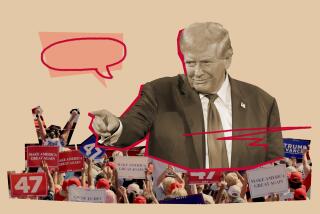Economists Suggest 2 Basic Flaws in Bush’s Job Pledge
- Share via
WASHINGTON — To economists, the most disconcerting thing that Vice President George Bush said in accepting the GOP presidential nomination Thursday night was that while Democrats just “talk, we (Republicans) deliver. They promise , we perform .”
Their apprehension centers on Bush’s surprising pledge, if elected President in November, to create 30 million new jobs in the economy in the next eight years. “My mission is: 30 in 8,” Bush said, beaming.
Both Republican and Democratic economists say that Bush’s proposal has two basic flaws:
First, no matter which party wins the November election, it simply is not possible for the U.S. economy to create 30 million new jobs without some serious side-effects, such as an inflation rate of 15% to 20%.
Second, even if it were, the United States physically would not have enough workers to fill them. The Labor Department estimates that the American labor force is likely to grow by only 12 million to 13 million workers by 1997. Even with today’s nearly 7 million unemployed workers, that is far short of what would be needed to fill 30 million jobs.
‘On Optimistic Side’
“The Bush figure is a little on the optimistic side,” said Fred Ribe, a fiscal analyst with the nonpartisan Congressional Budget Office.
Private economists agree. “It’s a physical impossibility, and any attempt to try to do so would put us in an impossible situation,” said Lawrence Chimerine, chief economist for Wharton EFTA, a Philadelphia-based economic research group.
As a result, economists suggested--tongue in cheek--that Bush may want to consider some companion “implementing” measures, such as forcing more housewives out of their homes and into the work force, repealing the nation’s child-labor laws and setting the Social Security retirement age at 72 or even higher.
David Wyss, chief financial economist for Data Resources Inc., a Cambridge, Mass., economic research group, said the United States might want to consider “eliminating the guards along the Mexican border.” That ought to boost the U.S. labor force by another 10 million workers, Wyss projected, and ease the inflation threat at the same time.
Former Jimmy Carter Administration chief economist Charles L. Schultze, now at the Brookings Institution, suggested annexing Canada and Australia, whose existing total employment could then be counted as “new” jobs for America. “Even then, we’d have to have unusually good economic growth here at home,” Schultze said.
Not at Face Value
Not everyone took the vice president’s pledge at face value.
“All (Bush) said was that he plans to create 30 million new jobs; he didn’t say that all these jobs would be filled,” Herbert Stein, former President Richard M. Nixon’s chief economic adviser, said jokingly. “You can simply have another 10 million vacancies.”
Stein, now at the American Enterprise Institute, offered two compromise proposals: Let everyone work at two jobs or reduce the minimum age for full-time workers to 7 and create most of the new jobs in computers. “These second-grade kids are good at computers,” he said, “but you have to raise their sights.”
The United States has created about 17 million payroll jobs in about the last 5 1/2 years, but that growth started from the trough of the 1981-1982 recession. The unusually rapid economic growth since then is not likely to be repeated, economists agree.
Today, the unemployment rate of 5.4% is very close to the level at which any further reductions in it would intensify inflationary pressures. Federal policy-makers are trying desperately to cool the economy down.
To generate 30 million jobs, however, would require massive new investment in the economy, according to Data Resources’ Wyss. That would happen only if the government provided huge incentives for investment, thus bloating the budget deficit and jacking interest rates up.
“It’s not even possible to do this, but if you just extrapolate, it would give you about a 20% inflation rate at the end of eight years,” Wyss said.
Generating 30 million workers would be harder yet. “For the first time in history,” Schultze said, “we’d have an unemployment rate of minus 10%. Even that wouldn’t be enough. We’d have to annex Canada and Australia as well.”
More to Read
Get the L.A. Times Politics newsletter
Deeply reported insights into legislation, politics and policy from Sacramento, Washington and beyond. In your inbox twice per week.
You may occasionally receive promotional content from the Los Angeles Times.










